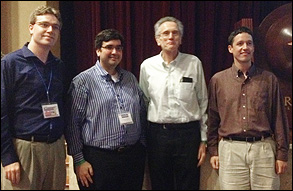News Story
Rueger Wins Mixing Forum Award

Past and current members of the Calabrese Group at NAMF 2012. Left to right: Justin R. Walker (Ph.D. '12), Gustavo A. Padron (M.S. '01, Ph.D. '05), Professor Richard V. Calabrese, and this year's NAMF Student Award winner, Paul E. Rueger. Walker and Padron have also won the award.
Rueger's work focuses on rotor-stator mixers, which are used to produce emulsions, materials consisting of one insoluble liquid dispersed as microscopic droplets within another liquid. (The oil and vinegar mixture shaken to create salad dressing is perhaps the best-known example.) As droplets of the dispersed liquid are moved around their surrounding liquid by the mixer, they encounter high levels of shear stress, which cause them to break apart into even smaller droplets. For dilute concentrations of the droplet phase, eventually the emulsion reaches its ultimate drop size distribution, a quantifiable, final degree to which one liquid can be dispersed into another liquid for a specific set of conditions.
"It's desirable to know what conditions are required to obtain which drop size distributions in industrial settings," Rueger explains. "That way we can accurately predict what to expect without the need to run those experiments in a plant, which would be very costly. Drop size distribution depends on things such as the rotor speed, the rotor-stator dimensions, the interfacial tension between the two liquids, and the viscosities of the two liquids. My goal is to develop expressions that will allow small-scale lab experiments to accurately predict the ultimate drop size distributions in large-scale systems with similar physical properties and experimental conditions."
While predictive mathematical models have been developed for systems where the continuous phase is a low viscosity liquid such as water, less information is currently available when it is a high-viscosity liquid like oil. Inside a rotor-stator mixer, the flow of low viscosity liquids is usually turbulent (chaotic), but thicker fluids may exhibit either a turbulent or laminar (orderly) flow.
Rueger's work expands on our ability to predict droplet size in high viscosity emulsions under both flow conditions. For turbulent flow, his study expanded the range of physical properties under which a previously known turbulent correlation has been experimentally verified. For laminar flow, his study provides an empirical correlation and, by comparison with previous work, discovered the mechanism by which drops breakup.
Rueger says that the new information could be beneficial in various contexts such as deep-sea oil drilling. At low temperatures and high pressures, methane hydrate gas dispersed in oil can freeze into masses capable of clogging pipes and pumps. Using these types of models and performing small-scale laboratory experiments, petroleum engineers can make predictions about how strong the shear fields in the pipeline have to be in order to break up the frozen particles sufficiently for them to pass through.
Rueger is the third member of the Calabrese Group to win the NAMF Student Award, which has been given only six times since 1997. Justin Walker (Ph. D. '12) won the award in 2010, Gustavo Padron (M.S. '01, Ph.D. '05) won in 2005, and two other group members, Karl Kevala (M.S. '01) and Supathorn Phongikaroon (Ph.D. '01), were finalists in 2003 and 2001, respectively.
"I am, of course, pleased to have won," Rueger tells us, "but I'd also like to point out that the fact that Professor Calabrese's students keep winning this contest shows everyone what I already knew: He really is an excellent advisor!"
Published July 23, 2012









